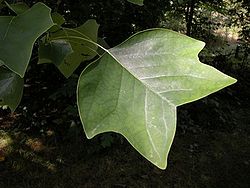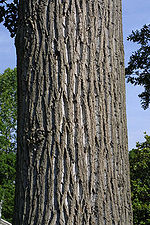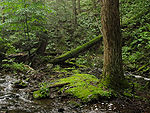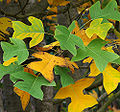Tuliptree
| Tuliptree |
|---|
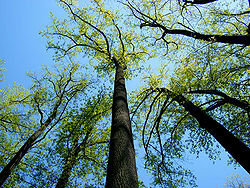
|
| Scientific Classification |
|
| Species |
|
| The leaf of a Tuliptree |
The Tuliptree is one of the members of the Magnolia family of ornamental trees. It is a taxonomic genus that consist of two species; which are Liriodendron chinense. and Liriodendron tulipifera The species are called multiple different names such as the yellow poplar, white poplar, white wood, Chinese Tuliptree and also American Tuliptree. They are known to grow very fast, (the tallest deciduous trees in North America ) and grow for over 200 years. They are valued for many different purposes including a food source for some animals and their woods for making furniture.[3] Liriodendron was introduced in 1688 and still remains to be a well populated growth. Later Ernest Wilson discovered the Liriodendron chinense (Hemsl.) Sarg which is commonly known as the Chinese Tuliptree in 1901. The name comes from the Tulips which resembles the flower. They are easily recognized due to the distinct shapes of the leaf and the colors of the bark. [4]
Body Design
Tuliptrees are one of the largest and tallest eastern American hardwood trees.[5] The Tuliptree wood is light colored brittle and soft with a malleable wood. The trunk of the tree has a gray color and very smooth texture. They are tall with straight trunk and are light weighted.[6] The tree is very recognizable due to the light-colored, narrow, and tapering features of the wood. The leaf and the petals also have distinct shapes that are very hard to mistake as the any other kind of tree. [5] Also the twigs are reddish-brown colored and the leaves are very distinct shape with dark color green, but they change color in the fall to yellow.They appear to look like the maple leaf that is cut off at the top.[6] The flowers have six petals that are formed with a variety of colors. Some one yellow, purple, orange and green with three large sepals at the bottom. The shape and the color changes depending on the climate and the nature of the trees placement. Also the name comes from the look of the flowers that are similar to a tulip.The leaf of the tree has four pointed tips that are hairless, glossy and also alternate .[3]
The Liriodendron can reach up to 90 inches or 30 meters in height and 10 meter wide. They are famous for their height and for the uniqueness of the leaves. The twigs and the branches come from far up the trunk and set pyramidal symmetrical to the trunk. Underneath the bark the sapwood is commonly white but the deadwood of the trunk in the center and also the branches are bright yellow. Also, the fruit of the Tuliptrees which are tiny vertical brown cones.[7]
Life Cycle
The Tulip trees grow rapidly in any region. Starting in late Spring , the distinctive leaves turn from a bright green to golden yellow in the fall. The leaves grow to at least 15 cm long and quickly grows. The flowers have multiple colors that resemble a tulip which only are found on trees that are 15 years. Also, the fruits appear after the flowers in the fall and they drop during the winter with the separations of pieces on the cone. However they leave the middle stalk for the following Spring produce.[8]
The Tuliptree flowers have six petals that generally produce during early April to June. Once they start growing they produce flowers for several weeks.If they do not pollinate early they can no longer fertile. Their stigma will turn brown if the flower does not open within one day they can no longer produce.Then the seed that the flowers contain get spread through their wings that float and distributes to other trees.Their growth occurs very fast in warm weathers and do not like the shade. However due to the fast growth of the trees they will escape the shade growing very tall. [3]
Ecology
Tuliptree are found in moist and soft soils with warm sunlight. They are mostly found in the east state in America. They are throughout the Mississippi River, southern New England and all the way to northern Florida. The Tuliptrees are found on the mountain slopes or streams where it is moist and full of sunlight. They do not grow well in shades but requires acidic soil and deep and rich moist with direct sunlight. [5] They also require moist soil due to the needs of constant water and gravel which will help them grow very fast and also drain the soil. The Tuliptree needs to avoid soils that does not drain very easily and get easily dried. The Liriodendron trees grow very fast due to the abundance of nitrogen and other nutrients but it will inhibit the growth if the soil does not receive a sufficient amount.[3] The trees are sometimes also grow in Georgia where the weather gets extremely hot. Even though the Tuliptrees are strong to grow in intense temperatures, they mostly grow in the area where they are covered by other elements such as shades.The trees get dehydrated around streams and lakes but they get the rest of nutrients from the soil. [5]
Uses
The Tuliptree contain many different uses.The nectar in the Tuliptree flowers attract the hummingbirds for their feed, other animals like rabbits, bobwhites, and squirrels also feed on the Tuliptrees but on the seeds instead of the flower.[9]The root of the tree has a lemon-like taste that serves and adds the bitterness to the beer. The bark of the tree also has the bitter taste.[5] The Liriodendrons also have medical uses, the inner bark of the tree have intensely bitter taste and use for tonic and stimulant. The tea also helps the health of humans to use as a treatment in cold, coughs and indigestion . The bark of the tree has Tulipferine which is extremely helpful to the humans nervous system and to the heart. The bark and the seeds help remove worms from the body and the tea is also used to heal wounds.The dye which is consumed from the bark can be used for furniture and other interior designs. Some of the Native North Americans use them to make canoes, because they are soft and light gold colored that are easy to work with. [10]
Video
Descriptions of the American Tuliptree
Gallery
References
- ↑ TulipTree.USDA. Web. accessed 2,May 2012. Author unknown
- ↑ Tuliptree.USDA. Web. accessed 2,May 2012. Author unknown
- ↑ 3.0 3.1 3.2 3.3 Argent,Gemma. The growth of tulip tree. ehow. Web. accessed on May 4,2012 .
- ↑ Tulip trees kew. Web. accessed on May 22,2012.Author Unknown (specify which).
- ↑ 5.0 5.1 5.2 5.3 5.4 Tuliptree. Nps. Web. Date-of-publication April 30, 2012 Author Unknown.
- ↑ 6.0 6.1 Characteristics of tulip poplar wood. ehow. Web. accessed on May 4,2012 Author unknown.
- ↑ Beaulieu, David.tuliptrees. about. Web. accessed on May 4,2012 .
- ↑ Tulip tree. newforestnpa. Web. accessed on May 6,2012 . Author Unknown.
- ↑ Burrell,Colston.Tulip Tree. howstuffworks. Web. accessed on May 20,2012.
- ↑ Liriodendron tulipifera - L.. Pfaf. Web. accessed on May 20,2012 Author Unknown.
